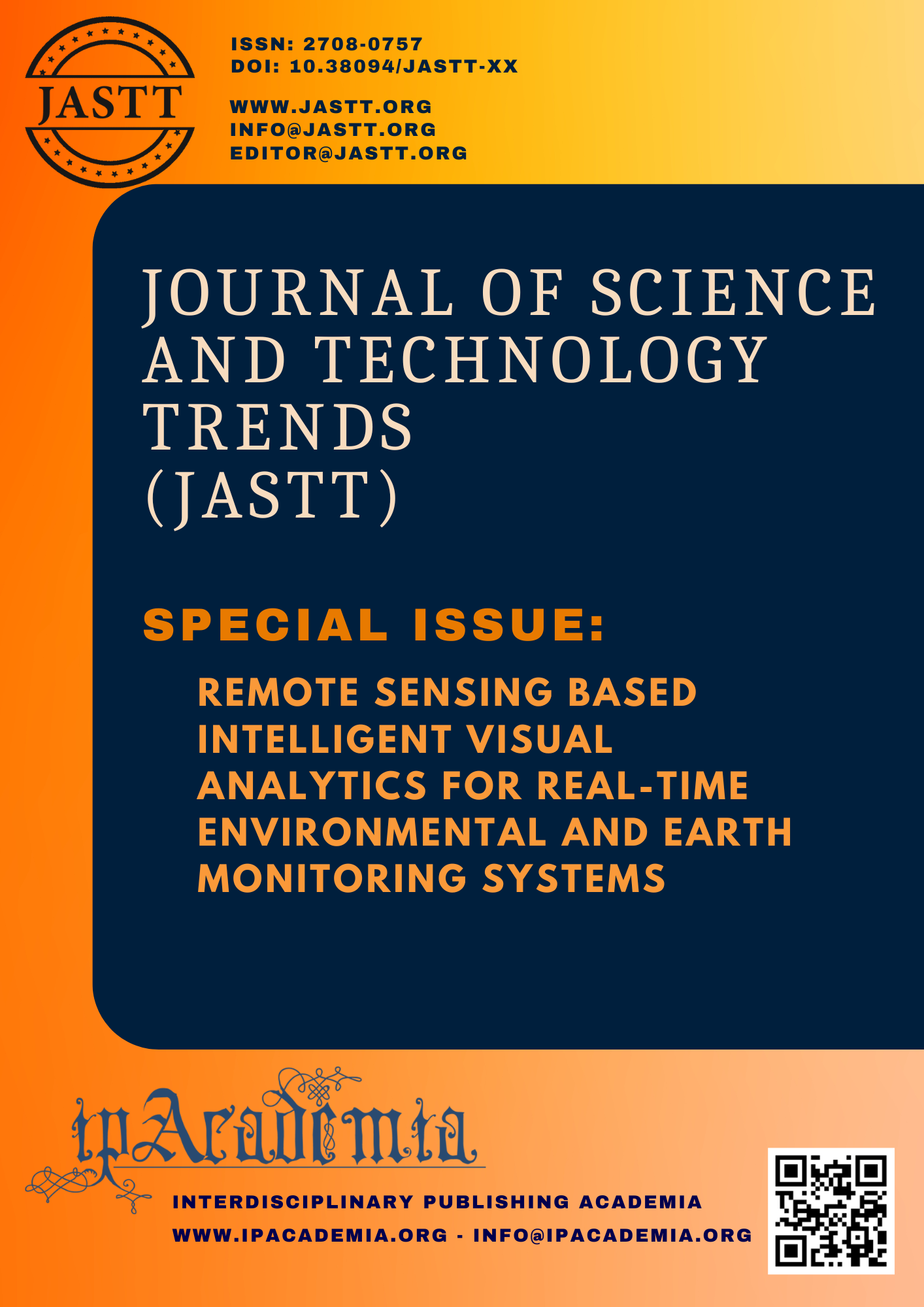Designing Remote-Sensed Intelligent Visual Analytics Algorithms for Environmental Monitoring Systems

Abstract
Increasing climate variability and the rapid degradation of natural ecosystems have necessitated the development of intelligent systems that can track and assess environmental changes in real-time. By combining multi-modal remote sensing data with advanced machine learning and visual analytics techniques, this paper introduces a novel framework for Remote-Sensed Intelligent Visual Analytics (RS-IVA), which aims to improve environmental monitoring systems. To offer a comprehensive, scalable, and adaptable monitoring system, the proposed framework utilizes ground sensor inputs, UAV-based aerial photography, and high-resolution satellite imaging. To identify anomalies such as deforestation, urbanization, water pollution, and changes in air quality, a hybrid deep learning-based algorithm is employed. Explainable AI (XAI) elements make sure that the decision-making process is transparent and accessible. To assist stakeholders, investigate spatiotemporal patterns, forecast environmental hazards, and enhance evidence-based policy decisions, an interactive visual analytics dashboard is being developed. Experiments using benchmark datasets demonstrate that the system is highly accurate in identifying significant environmental changes and exhibits greater adaptability across a wide range of climatic and geographic regions. Intelligent analytics and remote sensing technologies collaborate to improve situational awareness and provide early warnings for sustainable resource planning and disaster management. This research advances the development of next-generation innovative environmental monitoring systems by integrating human-in-the-loop visualization, AI-driven analytics, and remote sensing for informed ecological governance.
Keywords
Remote Sensing, Intelligent Visual Analytics, Environmental Monitoring Systems, Deep Learning, XAI, Spatiotemporal Analysis, UAV and Satellite Imagery
References
- L. Parra, “Remote Sensing and GIS in Environmental Monitoring,” Applied Sciences, vol. 12, no. 16, pp. 8045, 2022. https://doi.org/10.3390/app12168045
- O. Alsamrai, M. D. Redel-Macias, S. Pinzi, and M. P. Dorado, “A systematic review for indoor and outdoor air pollution monitoring systems based on Internet of Things,” Sustainability, vol. 16, no. 11, pp. 4353, 2024. https://doi.org/10.3390/su16114353
- Y. Sung, Z. Chen, J. Das, and P. Tokekar, “A survey of decision-theoretic approaches for robotic environmental monitoring,” Foundations and Trends® in Robotics, vol. 11, no. 4, pp. 225-315, 2023. http://dx.doi.org/10.1561/2300000073
- A. Hassani, P. Schneider, M. Vogt, and N. Castell, “Low-cost particulate matter sensors for monitoring residential wood burning,” Environmental Science & Technology, vol. 57, no. 40, pp. 15162-15172, 2023. https://doi.org/10.1021/acs.est.3c03661
- I. K. Waarum, A. van Hove, T. R. Krogstad, K. O.Ellefsen, and A. E. A. Blomberg, “Mixtures of Gaussian processes for robotic environmental monitoring of emission sources,” Environmental Monitoring and Assessment, vol. 197, no. 6, pp. 626, 2025. https://doi.org/10.1007/s10661-025-14059-6
- M. Sequeira, M. Bowden, E. Minogue, and D. Diamond, “Towards autonomous environmental monitoring systems,” Talanta, vol. 56, no. 2, pp. 355-363, 2002. https://doi.org/10.1016/S0039-9140(01)00601-4
- T. Miller, I. Durlik, E. Kostecka, P. Kozlovska, A. ?obodzi?ska, S. Soko?owska, and A. Nowy, “Integrating artificial intelligence agents with the internet of things for enhanced environmental monitoring: applications in water quality and climate data,” Electronics, vol. 14, no. 4, pp. 696, 2025. https://doi.org/10.3390/electronics14040696
- T. R. Salikhov, V. K. Abdrakhmanov, and T. T. Yumalin, “Application of Organic Sensors in Wireless Environmental Monitoring Systems,” In 2021 International Conference on Electrotechnical Complexes and Systems (ICOECS), pp. 500-503, 2021. https://doi.org/10.1109/ICOECS52783.2021.9657269
- G. Lanfranchi, A. Crupi, and F. Cesaroni, “Internet of Things (IoT) and the Environmental Sustainability: A Literature Review and Recommendations for Future Research,” Corporate Social Responsibility and Environmental Management, 2025. https://doi.org/10.1002/csr.70098
- S. Fang, L. Da Xu, Y. Zhu, J. Ahati, H. Pei, J. Yan, and Z. Liu, “An integrated system for regional environmental monitoring and management based on internet of things,” IEEE Transactions on Industrial Informatics, vol. 10, no. 2, pp. 1596-1605, 2014. https://doi.org/10.1109/TII.2014.2302638
- S. Asadzadeh, W. J. de Oliveira, and C. R. de Souza Filho, “UAV-based remote sensing for the petroleum industry and environmental monitoring: State-of-the-art and perspectives,” Journal of Petroleum Science and Engineering, vol. 208, pp. 109633, 2022. https://doi.org/10.1016/j.petrol.2021.109633
- F. S. Islam, “The role of artificial intelligence in environmental monitoring for sustainable development and future perspectives,” Journal of Global Ecology and Environment, vol. 21, no. 2, pp. 164-179, 2025. https://doi.org/10.56557/jogee/2025/v21i29272
- C. H. Chen, C. M. Hong, W. M. Lin, and Y. C. Wu, “Implementation of an Environmental Monitoring System Based on IoTs,” Electronics, vol. 11, no. 10, pp. 1596, 2022. https://doi.org/10.3390/electronics11101596
- S. R. Laha, B. K. Pattanayak, and S. Pattnaik, “Advancement of environmental monitoring system using IoT and sensor: A comprehensive analysis,” AIMS Environmental Science, vol. 9, no. 6, pp. 771-800, 2022. https://doi.org/10.3934/environsci.2022044
- S. L. Ullo, and G. R. Sinha, “Advances in smart environment monitoring systems using IoT and sensors,” Sensors, vol. 20, no. 11, pp. 3113, 2020. https://doi.org/10.3390/s20113113
- A. Petryaeva, M. Bolsunovskaya, S. Shirokova, A. Leksashov, A. Zhukov, A. Kuptsov, and A. Gintciak, “Analysis of Environmental Monitoring Systems Near Large Transportation Systems,” In International School on Neural Networks, Initiated by IIASS and EMFCSC, pp. 1385-1393, 2022. https://doi.org/10.1007/978-3-031-11058-0_140
- H. W. Song, W. Choi, T. Jeon, and J. H. Oh, “Recent advances in smart organic sensors for environmental monitoring systems,” ACS Applied Electronic Materials, vol. 5, no. 1, pp. 77-99, 2022. https://doi.org/10.1021/acsaelm.2c01315
- T. Johnson, and K. Woodward, “Enviro-IoT: calibrating low-cost environmental sensors in urban settings.” arXiv preprint arXiv:2502.07596, 2025. https://doi.org/10.48550/arXiv.2502.07596
- D. Mansfield, and A. Montazeri, “A survey on autonomous environmental monitoring approaches: towards unifying active sensing and reinforcement learning,” Frontiers in Robotics and AI, VOL. 11, PP. 1336612, 2024. https://doi.org/10.3389/frobt.2024.1336612
- M. M. Rahman, M. I. Joha, M. S. Nazim, and Y. M. Jang, “Enhancing IoT-Based Environmental Monitoring and Power Forecasting: A Comparative Analysis of AI Models for Real-Time Applications,” Applied Sciences (2076-3417), vol. 14, no. 24, 2024. https://doi.org/ 10.3390/app142411970
- https://www.kaggle.com/datasets/umeradnaan/remote-sensing-satellite-image